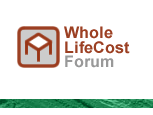
The Whole Life Cost Forum WLC Methodology
The WLCF reviewed all the work currently being carried out on Whole Life Cost and have adopted the folowing definition and methodology.
Definition
Whole Life Cost is the analysis of all relevant and identifiable financial cashflows regarding the acquisition and use of an asset.
Whole Life Cost is the analysis of all relevant and identifiable financial cashflows regarding the acquisition and use of an asset.
|
·
|
Relevant means those costs directly attributed to the asset under review.
|
|
·
|
Identifiable means we have to be able to quantify it in some way.
|
|
·
|
Assets can be whole buildings or a single small component.
|
|
·
|
Acquisition can mean the construction of a building or the purchase of a component
|
|
·
|
Use is all costs involved in the use of the asset.
|
Methodology
In brief the WLCF methodology is:-
In brief the WLCF methodology is:-
|
·
|
To calculate WLC all cashflows, both positive (inflows) and negative (outflows) need to be identified for each year of the intended life of the asset. See The Project as a Cashflow
|
|
·
|
The term asset can mean a structure made up of multiple components or to any individual component or series of components.
|
|
·
|
Cashflows are stated in actual cash terms ie all costs and incomes are at the levels expected in that year. There is no other allowance for inflation.
|
|
·
|
Asset Life is the life of the asset required to function at acceptable levels.
|
|
·
|
Day 1 of the Cashflows commences on the first outflow or inflow. (Note when considering large, complex assets such as buildings some other WLC methodologies start Day 1 from the completion of construction adding the cost of construction as a single cost.)
|
|
·
|
End of life costs are ignored on assesments with required lives longer than 10 years. (Note this is different from other methodologies and has been adopted to reduce risk and errors. For further information see End of Life Costs.)
|
Results
The results of the cashflows can be analysed as:-
The results of the cashflows can be analysed as:-
|
·
|
Actual Cashflows – the cashflows in each year.
|
|
·
|
Total WLC -
|
|
·
|
Annualised WLC Equivalent – the Total WLC divided by the required life.
|
|
·
|
Discounted Cashflow – the discounting of the annual cashflows to produce a Net Present Value (NPV) or Discounted Cashflow (DCF).
|
|
·
|
The WLC can be assessed at any point in the construction process or at any point in the asset chain.
|
|
·
|
WLC is more accurate when performance specification rather than product definition is used and the supplier or manufacturer.
|